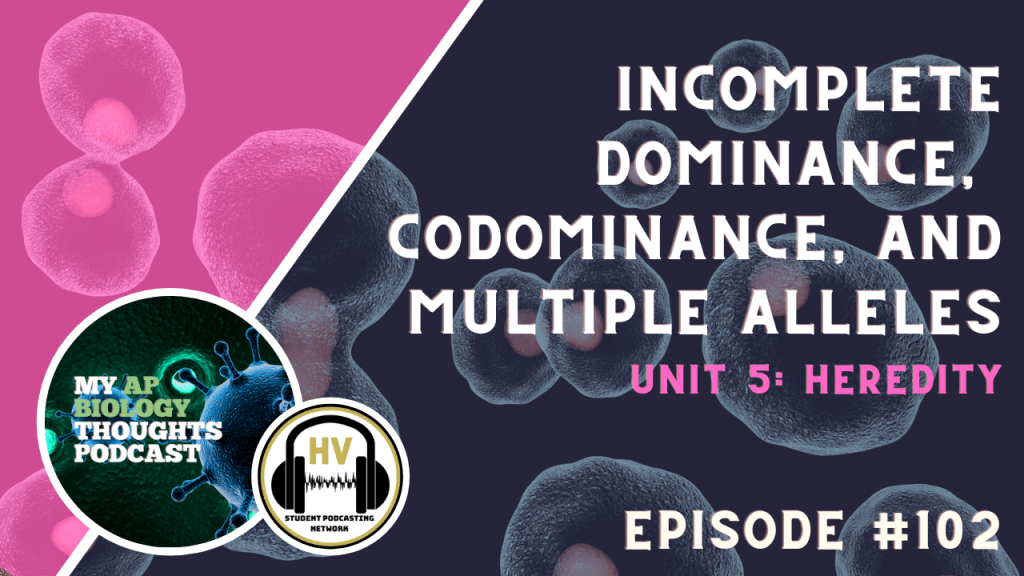Incomplete Dominance, Codominance, and Multiple Alleles

My AP Biology Thoughts
Unit 5 Heredity
Welcome to My AP Biology Thoughts podcast, my name is CJ and I am your host for episode #102 called Unit 5 Heredity: Different expressions of alleles. Today we will be discussing incomplete dominance, codominance and multiple alleles.
Segment 1: Introduction to expression of alleles
- Alleles are what make us unique, they code us and make us appear the way we are. In simple biology, we learn about how genotype affects phenotype and when we start off on this concept, we visualize a simple set of alleles. And when we first start to learn about alleles, we learn that dominant alleles override and affect the phenotype even if a recessive allele is present. Let’s use ear lobes as an example; we can say attached earlobes are recessive and loose are dominant. If the offspring has attached earlobes and both parents have unattached earlobes, we see a perfect example of simple inheritance. We would typically draw out a punnett square. We cannot directly see what’s the genotype of the parents, however we can assume that they are both heterozygous due to the nature that their offspring is homozygous recessive. When drawing out the Punnett square, we can see that there is a 50/50 chance that the offspring will have attached earlobes.
Segment 2: More About this
- However, nothing is ever that simple. As you can see, in the world around us, there are more than just two outcomes when it comes to anything living. In most cases, there are many more than just 2 phenotypes. The world is much more complicated than just dominant and recessive. That’s where incomplete dominance, codominance and multiple alleles come into play. They show us that there is much more to life than just capital and lowercase letters.To start off, incomplete dominance has the same number of alleles as a standard dominant and recessive genotype. The main difference is that heterozygous organisms no longer just express the dominant allele, they express a phenotype that is in between homozygous dominant and homozygous recessive. A great example of this is some sort of flower. If there are three colors of flower, one red, one white and one pink. The red can be determined as the “dominant” while the white could be “recessive”, making any flower with heterozygous alleles pink. This represents incomplete dominance. And just like incomplete dominance, codominance is only made up of a single set of alleles too. However, instead of the phenotype being somewhere in the middle, for codominance, the phenotype for heterozygous is a mix of the two. Meaning if a species is represented by the genotype of one dominant and one recessive, they are going to express both phenotypes, in their own respective way. Now for when alleles get complicated. When there are multiple alleles, the same rules apply for simple dominance, where the heterozygous only expresses the dominant phenotype. However, there are more alleles that influence the phenotype as well. Depending on the trait, there could be 4 or more alleles that determine what a species looks like. Just like in eye color, where there are 16 different genes that determine what colors your eyes could be. And in theory you could use a Punnett square to determine the predicted offspring phenotypes, but that square would be substantially larger and more complicated as different letters are flying around.
Segment 3: Connection to the Course
- All in all, a variety of things can influence how a species can look. And the different expression of alleles can alter those looks even more. But that’s all there for a cause. All of these alleles got there somehow, whether it be natural selection or a random mutation that had the benefit of the doubt. But these alleles can show us whether a recessive trait is more fit for one environment than another. All of this has a purpose, everything happens for a reason, and looking at alleles we can now predict what the outcomes could be.
Thank you for listening to this episode of My AP Biology Thoughts. For more student-ran podcasts and digital content, make sure that you visit www.hvspn.com. SEEYA!
Music Credits:
- “Ice Flow” Kevin MacLeod (incompetech.com)
- Licensed under Creative Commons: By Attribution 4.0 License
- http://creativecommons.org/licenses/by/4.0/
Subscribe to our Podcast
Connect with us on Social Media
Twitter @thehvspn
Welcome to My AP Biology Thoughts podcast, this is episode #102 called Unit 5 Heredity: Different expressions of alleles.

